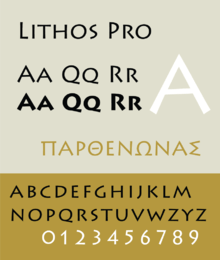Samples of simulation typefaces
A simulation typeface is one designed after a unique or stereotypical aspect of the letterforms or scripts of a different language.[1][2][3]
| Name | Example 1 | Example 2 | Example 3 |
|---|---|---|---|
| Bagel (typeface) (Hebrew/Latin) | | ||
| Circumcision (typeface) (Hebrew/Latin) | | ||
| Faux Arabic (Arabic/Latin) | | ||
| Faux Chinese (Chinese/Latin) | | ||
| Faux Hebrew (Hebrew/Latin) | | ||
| Faux Sanskrit (Devanagari/Latin) | | ||
| Hananiah (typeface) (Hebrew/Latin) | | ||
| Herculanum (typeface) | | ||
| Lithos (Greek epigraphic/Latin) |  | ||
| Rusticana | |  | |
| Samarkan (typeface) (Devanagari/Latin) |  | ||
| Sherwood (typeface) | | ||
| Skia (typeface) (Greek epigraphic/Latin) |  |  |  |
| Talmud (typeface) (Hebrew/Latin) |  |
See also
- Typeface
- Samples of display typefaces
- Samples of monospaced typefaces
- Samples of sans serif typefaces
- Samples of script typefaces
- Samples of serif typefaces
References
- ↑ Tereza Haralambous and Yannis Haralambous, "Characters, Glyphs and Beyond", Glyph and Typesetting Workshop, Kyōto, 2003. PDF, p. 24
- ↑ Chachra, Deb. "Faux Devangari". HiLoBrow. Retrieved 1 October 2014.
- ↑ Shaw, Paul. "Stereo Types". Print Magazine. Retrieved 1 October 2014.
This article is issued from Wikipedia - version of the 4/21/2016. The text is available under the Creative Commons Attribution/Share Alike but additional terms may apply for the media files.